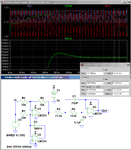PomPom
Junior Member level 3
I'll probably end up using an ADC on a microcontroller, but i'd like to do this in an analog fashion.
i want to take an audio signal, say 200-10k Hz, and see what it's average value is. i've seen the rectifier circuits with the RC on it, but it gives too much ripple on the output.
accuracy is not terribly important, i just want no ripple. i want a scalable, linear, but not necessarily accurate representation of RMS. It's for a guitar pedal design.
so basically, as you play a sustained amount of music, i want a signal that ramps up (hopefully quickly, or have this be adjustable via POT), and then hits a value which represents quasi-RMS. then as the signal goes away this ramps back down to 0. i'd like to avoid ripple as much as possible.
how can i do this? i don't reeally want to do it in the micro, analog is more fun.
i've done a lot of simulations.
i've tried precision diode circuits, with RC to get an average value, and it's possible to get the ripple to disappear, but i can't get it to be good in my entire range of frequencies.
integrator sort of works, but i can't get it to flatten out at some point to represent a "constant power"
i simulated an LTC1996 (i believe, one of LT's rms-dc converters) and again, too much ripple.
thank you.
i want to take an audio signal, say 200-10k Hz, and see what it's average value is. i've seen the rectifier circuits with the RC on it, but it gives too much ripple on the output.
accuracy is not terribly important, i just want no ripple. i want a scalable, linear, but not necessarily accurate representation of RMS. It's for a guitar pedal design.
so basically, as you play a sustained amount of music, i want a signal that ramps up (hopefully quickly, or have this be adjustable via POT), and then hits a value which represents quasi-RMS. then as the signal goes away this ramps back down to 0. i'd like to avoid ripple as much as possible.
how can i do this? i don't reeally want to do it in the micro, analog is more fun.
i've done a lot of simulations.
i've tried precision diode circuits, with RC to get an average value, and it's possible to get the ripple to disappear, but i can't get it to be good in my entire range of frequencies.
integrator sort of works, but i can't get it to flatten out at some point to represent a "constant power"
i simulated an LTC1996 (i believe, one of LT's rms-dc converters) and again, too much ripple.
thank you.
